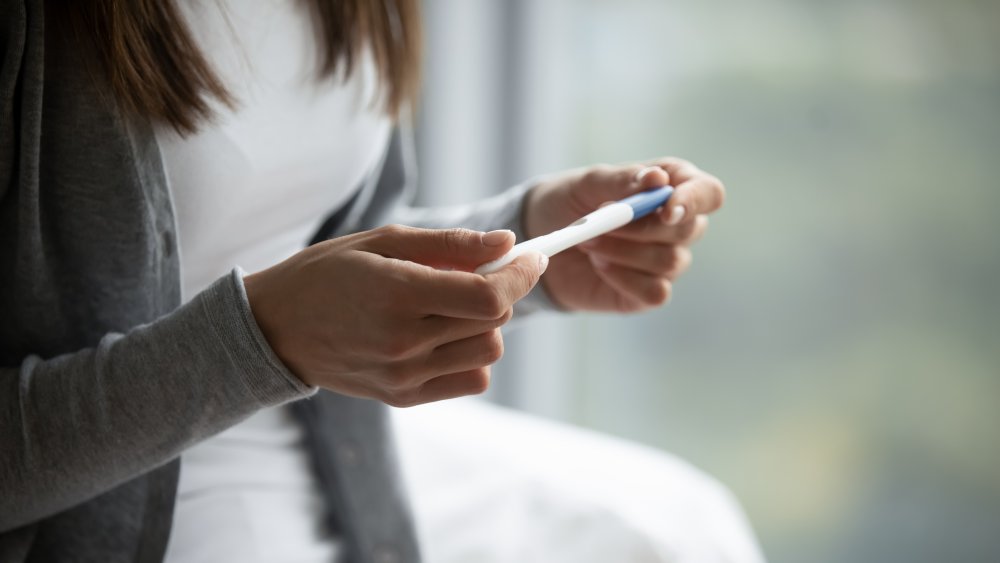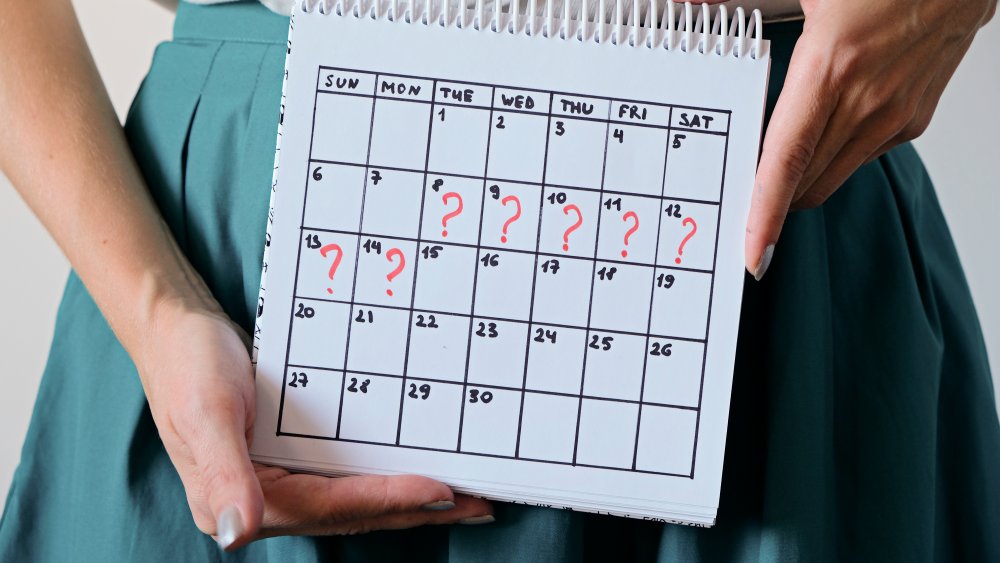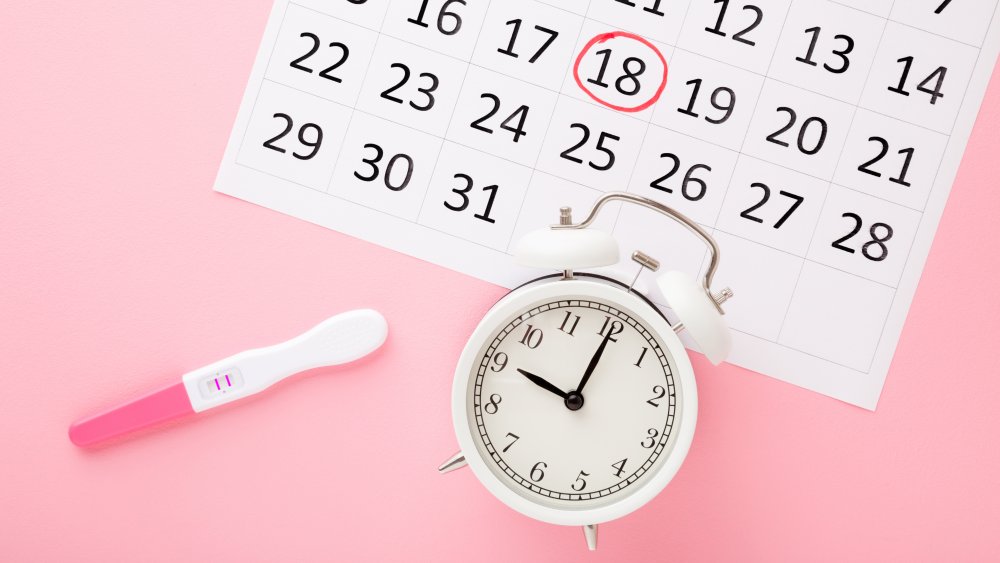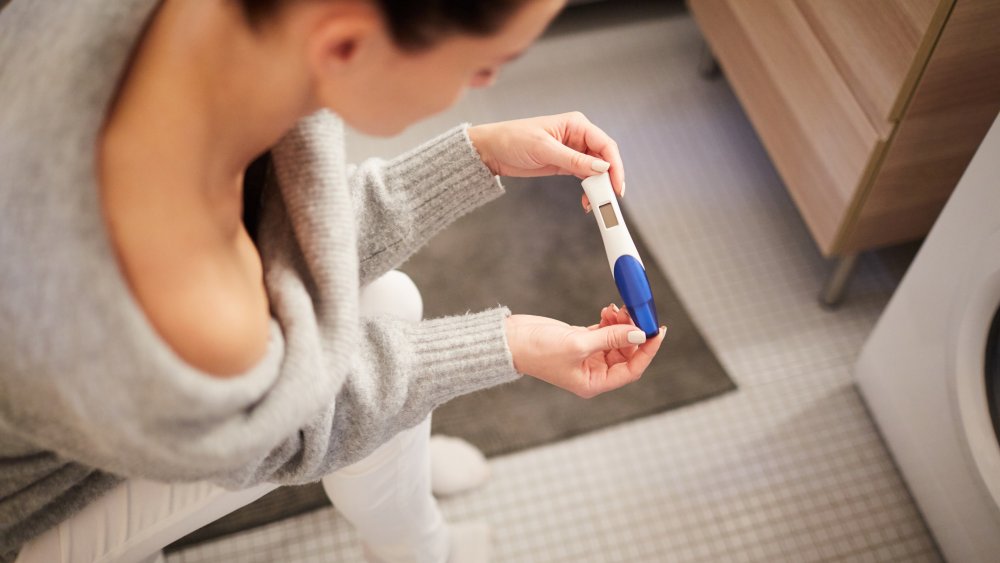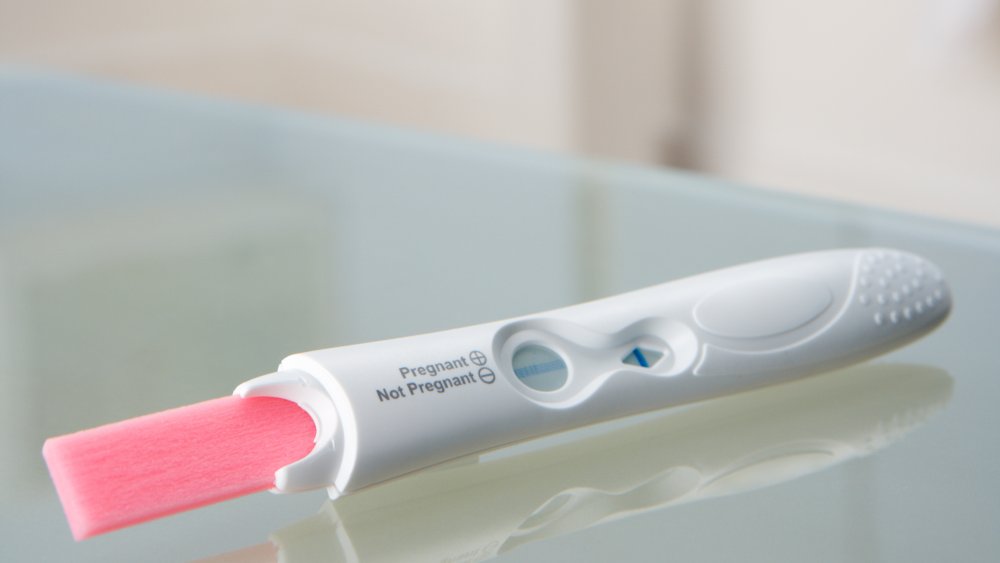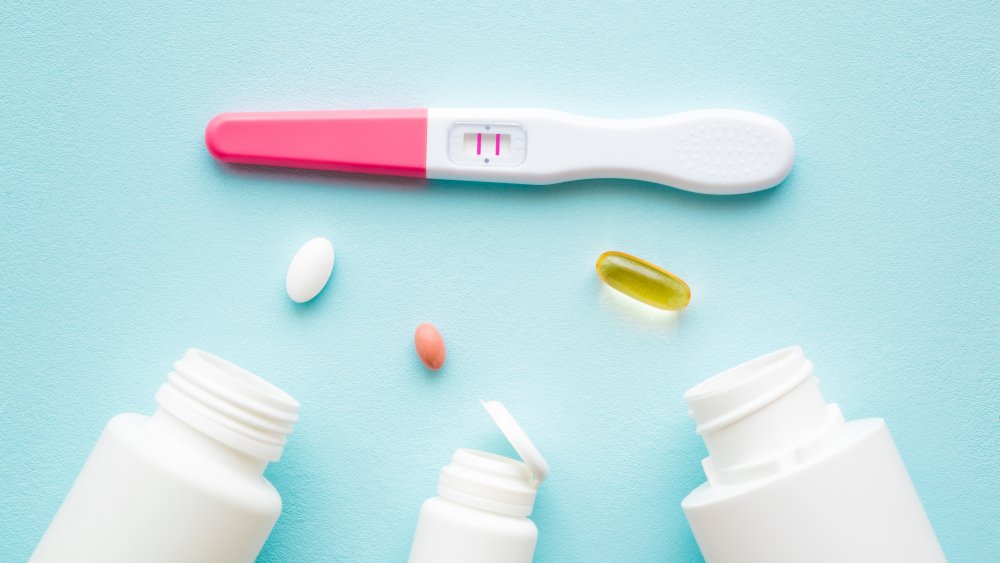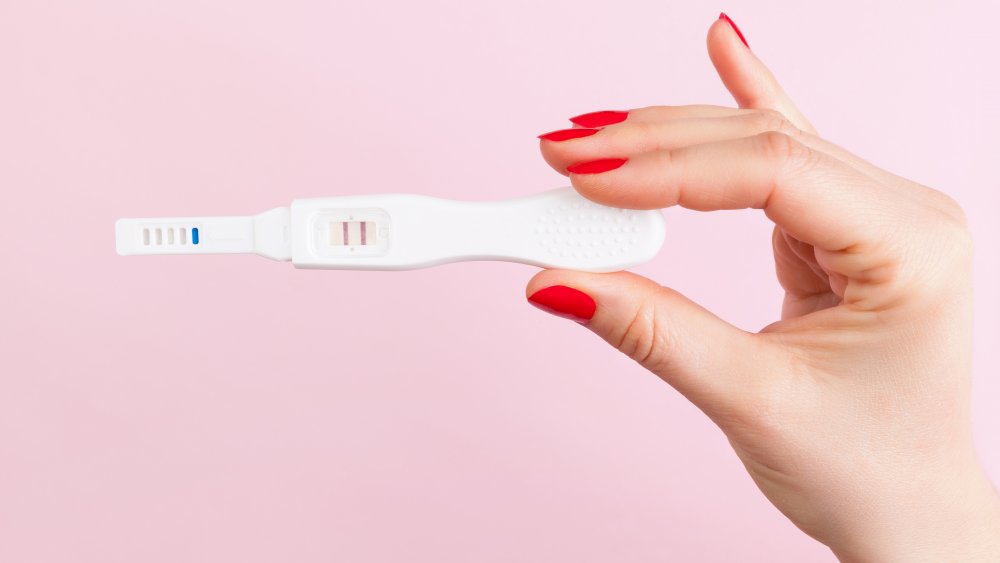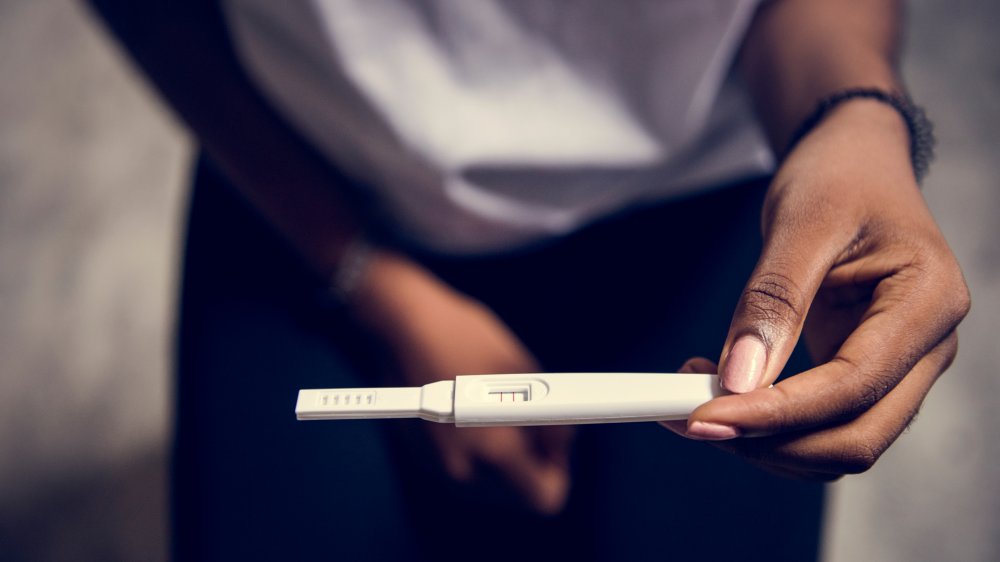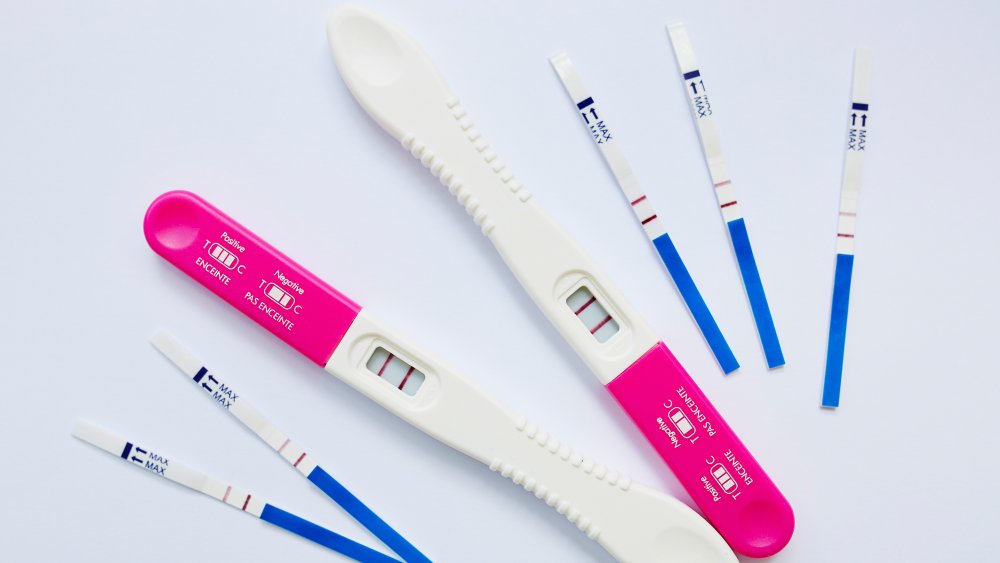Don't Make These Mistakes When You Take A Pregnancy Test
Taking a pregnancy test can feel like a monumental event — and with good reason. There is a lot riding on the result; so, yes, peeing on a stick is a very big deal. You may be feeling nervous, excited, worried, elated, or panicked. Heck, you are probably feeling a combination of a few — if not all — of these emotions. You just want need an answer stat. But before you make your way to the nearest drug store to purchase all the tests, take a second and do some due diligence.
There are a few important things to know before you take a test, and several common mistakes you will want to try to avoid. The fact is: One or two seemingly silly missteps could be the difference between an accurate result and one that's completely questionable. So take a deep, cleansing breath, pour yourself a drink (but make it a non-alcoholic one, just in case!), and read up on all the do's and don'ts of taking an at-home pregnancy test. Good luck!
Mistake: You take a pregnancy test too early in your cycle
If you are waiting with bated breath to find out if you are pregnant, you might be tempted to take a test ASAP. But peeing on a stick too soon won't give you the peace of mind you're looking for — whether you're wishing for a positive or hoping for negative. In fact, testing too early could yield a false negative as the human chorionic gonadotropin (hCG) hormone in your system may not yet be detectable. It's also possible, though rarer, to get a false-positive result. "A false-positive might happen if you had a pregnancy loss soon after the fertilized egg attached to your uterine lining (biochemical pregnancy)," the Mayo Clinic explained. In short, for the sake of accuracy, try to wait until you have missed your period.
According to Verywell Family, most tests that are advertised as "early" detectors of pregnancy rely on a 14-day luteal phase — two weeks from ovulation to your period. Of course, not every woman's period is punctual or predictable, so do you best to chart it out and wait. On the day of your missed period, these tests typically boast a 99 percent accuracy rate, though that figure may more realistically be 46–89 percent.
Mistake: You use the wrong type of pregnancy test
If this is your first time browsing the family-planning section of your pharmacy, you will likely find yourself completely overwhelmed by the multitude of options. There are blue dye tests, pink dye tests, and digital tests. Urine activates a chemical reaction in the dye tests that, depending on a positive or negative result, reveals one or two lines or a plus or minus sign. Digital tests, which are usually more expensive, typically display the words "pregnant" or "not pregnant." However, they may be less sensitive to hCG — so if you're testing early, maybe skip this option (via Romper).
While the two types of dye pregnancy tests are usually equally effective, many find the blue tests slightly more prone to an evaporation line. This shadowy line can look like a second colored line, and it could appear after the allotted wait time has passed. In other words, you might read the test as positive, when it's actually negative. Since this questionable hint of a line is closer to a blue hue, you may end up more confused and less confident about the results. To this end, Dr. Sherry Ross, an obstetrician-gynecologist, told Romper that she advises sticking with pink dye tests.
Mistake: You read the pregnancy test too soon after taking it
If you are feeling nervous about getting your result, you might want to rip open the box and pee on that stick posthaste. But take a beat and a breath, and do yourself the favor of reading the included instructions. While most at-home pregnancy tests work in a similar way, there are some nuances: Are you supposed to pee on the stick or dip it in a cup of urine? Are you supposed to hold it in a certain direction to allow for the flow of urine? Should you put the cap back on or leave it off while you await your result?
The fine print will undoubtedly answer your mounting questions. One especially important piece of information to note is the amount of time you need to wait before reading the results. It can be tempting to stare at that little test window, but put it down and set a timer. If you are indeed pregnant, the chemical reaction might not be immediate; it could take a few minutes for the hCG to be detected and that tell-tale line to form, according to Verywell Family. Keep calm, and carry on. Just don't check too early.
Mistake: You wait too long to look at the results of your pregnancy test
A pregnancy test's instructions are there for a reason and, yes, you're supposed to wait a specific amount of time to check the results. This means you shouldn't eagerly check too early, but almost more importantly, don't wait to check after the recommended time frame has passed.
Reading a test late makes it possible and likely for you to identify an evaporation line that has suddenly appeared and think it's actually a positive. (It's not.) As explained by Healthline, an evaporation line "appears in the results window of a pregnancy test as the urine dries. It can leave a faint colorless line." While it's not bold, it still can cause major confusion. Although an evaporation line can form even if you don't wait too long, "the risk of a false positive is higher when you read your results after the reaction time," the publication explained.
Avoid rechecking a used negative test after the result window expires, If you do, you might see that little hint of a line and start questioning yourself. And if you are hoping for a baby, this can cause disappointment. If necessary, test again. Just follow the directions, and — quick reminder — set an alarm on your phone.
Mistake: You take a pregnancy test at the wrong time of day
We get it. You are sitting at your desk working when you suddenly get hit with an overwhelming suspicion or intuition — are you expecting? It can be hard to resist the urge to immediately run to the pharmacy, grab a test off the shelf, and race back to use the bathroom. If you are desperate to get an answer asap, well, go for it. However, understand that if it's before your missed period or just around the time you are expecting it, you may be better off waiting until the next morning. Yes, that's right, we are telling you to sleep a whole night before taking that fateful test — but for good reason.
As explained by Healthline, "your first morning urine" boasts the highest concentration of human chorionic gonadotropin (hCG) levels early in pregnancy. You have been asleep all night (well, hopefully!), so you haven't been drinking or peeing. This means that, if you are pregnant, the urine concentration of hCG should be high.
Mistake: You use an expired pregnancy test
Not all pregnancy tests are sold individually; some are sold in boxes containing two (or more) tests. And if you happened to have bought a two-pack, used one test, and stored the other away for a rainy day missed period, you might want to check the packaging — after digging it out from the back of the medicine cabinet and before commencing operation: pee on a stick. As it turns out these items have a finite shelf life so, you're going to want to consult the expiration date.
Tempting as it may be to use the expired pregnancy test already in your possession, it could lead to getting an inaccurate reading. As noted by What to Expect, "pregnancy tests that are past their expiration date are more likely to give you a false negative or a false positive reading." Save yourself the anxiety, the confusion, and the potential heartache by buying a new one that is not expired.
Mistake: You don't take into account medications that can affect the outcome of your pregnancy test
If you've been trying to get pregnant, a positive pregnancy test result is, of course, something to celebrate. Nevertheless, avoid setting yourself up for disappointment by being aware of some medications that could indicate a false positive.
Many fertility drugs — including the ones used during in vitro fertilization (IVF) — contain human chorionic gonadotropin, the same pregnancy hormone that causes the chemical reaction on a test strip indicating pregnancy. Dr. Zev Williams, Columbia University professor of obstetrics and gynecology, explained to Self that "women who are very motivated and trying to conceive ... will often do the pregnancy test early and see a positive result, which is obviously very exciting for them initially." He continued, saying, "But it just might be the result of the fertility medication that they took." For this reason, Williams said that most doctors will warn their fertility patients not to test too early as it can lead to "false hope."
Mistake: You don't evaluate the pregnancy test for potential false positives
You may be ready to rejoice the moment you see the positive result on a pregnancy test, but you should be aware of what can cause false positives. This isn't cause for panic; enjoy your happy moment but educate yourself on all the possibilities.
If a woman experiences a miscarriage and tries to get pregnant again in subsequent weeks, she could get a false positive. Columbia University professor of obstetrics and gynecology, Zev Williams, explained to Self that hCG can stay in a woman's system for weeks or even months. "As long as there are viable growing placenta cells inside the woman, those tests can be positive." Yes, even if she is no longer technically carrying.
An ectopic pregnancy could also lead to a false positive. According to WebMD, this occurs "when a fertilized egg grows outside a woman's uterus, somewhere else in their belly." While the pregnancy is not viable, the embryo will still continue making hCG and thus a false-positive reading. If your pregnancy test came back positive and you are experiencing severe abdominal cramps, bleeding, or dizziness, consult your doctor. An ectopic pregnancy can be a life-threatening emergency.
Mistake: You reuse a pregnancy test
This one may be able go without saying, but here goes: Do not attempt to reuse a used pregnancy test. We get it: desperate times call for desperate measures. And, hey, we are all for recycling. But peeing on that same stick twice is not going to give you any clarity.
As explained by Healthline, when you urinate on a pregnancy test stick, a chemical reaction takes place. Once the reaction has occurred on that testing strip — whether positive or negative — you can't use it again as it will not yield a second chemical reaction. This also means that if you have accidentally dropped it in the sink under running water, you will need to throw it away and get a new one. Once a strip is wet — with any liquid — the test has got to go. What's more, if you try to get a second result, an evaporation line may appear, giving you a false positive reading.
Mistake: You spend a fortune on brand-name pregnancy tests
If you're someone who wants to test all day every day, you've probably realized that your stick-peeing habit is adding up to be quite the expense. Depending on which box you pluck off the pharmacy shelf, you could be shelling out between $5 and $25 dollars every time you get the impulse to check (via What to Expect).
Digital pregnancy tests are usually priced on the higher end, and those dye tests that claim to give you the earliest results possible might also be a bit more expensive. If you want to test for a potential pregnancy often but perhaps don't want to use up your maybe-baby's entire college fund, consider opting for a cheaper way. You can find bulk options on Amazon or generic-brand strips at a local dollar store. They may not boast all the frills (it's probably just a flimsy strip without the plastic encasement), but they're just as accurate if used properly on the first day of your missed period.
Mistake: You don't follow up with your doctor after a positive pregnancy test
You got that positive result you have been hoping and dreaming for — congrats! Your pregnancy journey and the path to parenthood is officially beginning, and there is no time to waste. You may think that you can ride out the first trimester of your pregnancy (or at least the first month or so) without talking to your doctor, but you'd be majorly mistaken. In fact, one of the very first things you should do when you see those two lines is call your obstetrician-gynecologist and schedule your initial prenatal appointment. It might not take place for a few weeks, but you'll likely get some important information in advance.
If the receptionist, nurse, or doctor doesn't give you a quick briefing, feel free to call and ask the basics. What vitamins should you be taking? Is there anything you shouldn't be doing or eating or drinking? Finally, give them a heads-up if you have any concerns, if you have a chronic illness, or if you have had miscarriages in the past; these factors may motivate your doctor to want to see you even sooner (via What to Expect).
Mistake: You don't follow up or take another pregnancy test after a negative result
Getting a negative pregnancy test result when you are hoping for a positive one can feel absolutely earth shattering — especially if this is not the first time. Take a deep breath and give yourself a moment to feel your feelings.
Here is the thing, though, not all hope is lost — especially if you tested before the date of your expected next period. As noted by Verywell Family, most tests suggest waiting a week before taking another one, but since hCG levels double every two days, you could technically try again a few days later. Try to temper your expectations, but it is possible for you to be pregnant and have the test come back negative; your body just might need a bit more time to work up those hormone levels.
If you continue to get negative results but fail to get your period as anticipated, call your doctor. In some instances, an obstetrician-gynecologist might make the call to do a blood test to look for more specific answers. The same applies if you start having pregnancy symptoms and continue to get a negative result. There might be medical issues at play, so follow up with your doctor (via Verywell Family).

